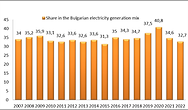HOME > NUCLEAR ENERGY > BULGARIAN NUCLEAR PROGRAM
The beginning of the nuclear programme in Bulgaria was set after the First UN Geneva conference (1955) based on the ‘atoms for peace’ premise and has remained the strategy of the Bulgarian national policy ever since.
In 1957, within the United Nations family, the International Atomic Energy Agency (IAEA), the world’s center of cooperation in the nuclear field, was set up. Bulgaria is a country co-founder of the IAEA and is a full pledged member as of its establishment.
In June 1957, a Committee for the Peaceful Use of Atomic Energy (CPUAE) was established by decision of the Council of Ministers. Its main functions are to develop and to coordinate the programs on the peaceful use of atomic energy as well as to organize the international cooperation in this field.
The first step in peaceful use was the construction of the IRT-2000 research reactor and implementation of a programme for nuclear applications and scientific research. The reactor was commissioned in 1961. In 1999, it was permanently shut down based on a Council of Ministers’ decree.
In 1966, an agreement with the Union of Soviet Socialist Republics was signed for the procurement of commercial reactors for electricity generation. This agreement set the foundations of the Bulgarian nuclear power programme.
The commissioning of the first Kozloduy NPP power unit in 1974 marked a significant achievement in the modern history of the country – the beginning of nuclear energy not only in Bulgaria, but also in southeastern Europe.
The construction of the plant nuclear facilities was executed in three stages during the period of 1970 – 1991:
1970 – 1975: Construction and commissioning of Units 1 and 2 with water-water reactors WWER-440 (V-230) and two independent safety system trains. Unit 1 was commissioned in 1974, and Unit 2 – in 1975.
1973 – 1982: Construction and commissioning of Units 3 and 4 with water-water reactors WWER-440 (advanced V-230), and triply redundant safety systems. Unit 3 was commissioned in 1980, and Unit 4 – in 1982.
1980 – 1991: Construction and commissioning of Units 5 and 6 with water-water reactors WWER-1000 (V-320), containment and triple redundancy of the safety systems. Unit 5 was commissioned in 1987, and Unit 6 – in 1991.
As a result of its activity throughout the years, the nuclear power plant has become a determining factor for the stability of the national energy system and today Kozloduy NPP is the largest electricity producer in Bulgaria.
Between 2014 and 2018, the Plant Lifetime Extension (PLEX) Project was completed for units 5 and 6. The project results demonstrated the units’ technical capabilities for long term operation — until 2047 for Unit 5 and 2051 for Unit 6, respectively. Subsequently NRA issued extension of the operating license for Unit 5 until 2027 and for Unit 6 until 2029.
After closure of units 1-4 of Kozloduy NPP a comprehensive program for their decommissioning is under implementation. After defueling, units 1-4 were transferred to State Enterprise Radioactive Waste for performance of the activities for decontamination and demolition of structures, systems and components of the units.
The development of the Bulgarian nuclear program includes plans for the construction of new power units.
A second site for construction of new nuclear units was selected in the early 1980s near the town of Belene and throughout the years substantial efforts are invested in the development of subsequent projects on this site.
In 2020 another site for construction of new units was approved, adjacent to Kozloduy NPP site.
Currently the projects to construct nuclear power plants on these two sites are at different stages of development in view of the justified needs for additional nuclear generating capacities as per the national energy strategy of the country.
